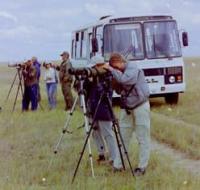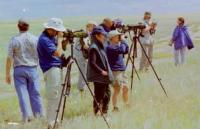You are here
Sighs Korgaldzhin reserve.


Observing excursion tour Korgalzhyn reserve.
“A tulip doesn’t strive to impress anyone. It doesn’t struggle to be different than a rose. It doesn’t have to. It is different. And there’s room in the garden for every flower. You didn’t have to struggle to make your face different than anyone else’s on earth. It just is. You are unique because you were created that way. Look at little children in kindergarten. They’re all different without trying to be. As long as they’re unselfconsciously being themselves, they can’t help but shine. It’s only later, when children are taught to compete, to strive to be better than others, that their natural light becomes distorted.”
Marianne Williamson.
Excursion tour Korgalzhyn reserve.
Lake Tengiz is a steppe lake without an outlet. It takes in most of its volume from the Nura River, and the water is brackish. The lakes of Korgalzhin are fresh water, and are embedded in an immensely vast sea of reeds, home to tens of thousands of water birds.
Ornithologists have counted almost 330 species of indigenous and migrant birds, almost 20 of which are threatened with extinction. Lake Tengiz hosts the northernmost and largest colony of pink flamingoes in the world, with up to 14,000 pairs making their nests out on the lake.
On Lake Sultankeldy you can observe Dalmatian pelicans and great cormorants, demoiselle cranes, great egrets, great and little bitterns, ruffs, dozens of different types of geese and ducks, many kinds of wader, pratincole, the sociable lapwing and black lark, and last but not least, numerous predatory birds such as the northern harrier, long-legged buzzard, lesser kestrel and steppe eagle, all of which populate the reserve.
In all, this is a paradise for ornithologists, but of course other animals live here too, such as the wolf and fox, marmot, ground squirrel and horse springer (a kind of jumping mouse), and even a few rare saiga antelope.
The salt and feather grass steppe of this region contains more than 300 species of plant. The reserve's staff can organize either group or individual visits; the season starts in late April early May when the tulips bloom, and ends in mid-September with the impressive autumn bird migration.
Individual travellers and small groups can stay overnight in Korgalzhyn, the administrative centre of the protected area, as well as in Karazhar, one of the research centres in the protected area itself. After checking for space and booking in advance, you make your way to Korgalzhyn, a rural settlement of 6,000 inhabitants, and check into one of the modest but friendly family boarding houses, which cost about US$30 a night, including good catering.
Worth seeing in the village are the museum devoted to the protected area, with a good collection of birds, and the new visitors' centre. Ornithological excursions are forbidden in the protected area itself, but almost all bird species that come here can be seen in the meadow woods and on the steep banks of the Nura, on Sholak Lake and other lakes outside the core zone.
Visits into the protected area must be applied for to the director himself.
Authority:
“The guidebook across Kazakhstan” . Authors Dagmar Schreiber and Jeremy Tredinnick. Publishing house "Odyssey".2010.
Photos by:
Alexander Petrov.







